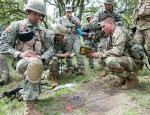Grayson Makris contemplated how his platoon was going to proceed as he planned its mission on a terrain model he drew in the dirt in front of him.
The platoon had just been assigned a mission from its superiors, and, as the platoon leader, Makris’ job was to design and execute a plan of attack. Makris, a third-year geography student and an ROTC cadet, cleared away grass and brush from the ground, using pieces of string to depict roads and felt dots to indicate enemy encampments. He had to communicate his plan with the rest of the platoon if he was going to complete the mission.
The mission was a part of UCLA Army ROTC’s annual Spring Field Training Exercise in April. Cadets lived in Camp Roberts, an army base in central California, for three days and simulated U.S. Army infantry missions.
Maj. Tyrone Vargas, an assistant professor of military science at UCLA, said ROTC cadets must learn in training to think creatively to reach objectives and complete missions in order to be successful in leadership roles in the military.
“It’s not about just following what I say,” Vargas said. “It’s about what we’re going to do next.”
Lt. Col. Shannon Stambersky, who leads UCLA’s battalion in ROTC and is a professor of military science at UCLA, said the ROTC program aims to build on cadets’ individual strengths to help them complete missions. For instance, Edwin Chang, a fourth-year geography student, uses his photography skills on missions as a public affairs officer for ROTC and takes photos to help publicize and document the program.
“You’re not put into a box of what you can and can’t do,” Stambersky said. “You get to see what you’re good at, develop those skills and choose a branch that fits you.”
After each exercise, ROTC leadership conducts an after-action review to reflect on the platoon leaders’ decision-making processes during the missions and hone their critical thinking skills. The platoon leader, who is chosen at random before missions are assigned, stands in front of the platoon and recounts every step of the mission and every choice he or she made. At the same time, fourth-year cadets and ROTC leadership interject throughout the review to explain what the cadets could have done better.
In their fourth year of training, cadets serve as mentors to younger students in ROTC. Robert Fretz, a fourth-year political science student in the UCLA battalion, said the purpose of ROTC is to cultivate officers of all leadership styles.
“The whole part of ROTC is to develop leaders in the army, and there are many different ways to lead,” Fretz said.
At one point during a mission, Fretz took aside a third-year cadet, who was a platoon leader in an earlier stage of the mission, for evaluations. He asked the platoon leader to recount everything that happened during his part of the mission in chronological order and to explain his decision-making.
The cadet said he felt he was not able to command the other cadets’ attention because he was an introvert. Fretz replied that the cadet had to experiment with his leadership style and see what worked best for him to motivate the cadets under his command.
“I told him most officers end up being introverts as they progress in their ranks anyway and that it wasn’t something to be ashamed of,” Fretz said. “The goal out here is to help people learn. We want them to do well; we want them to succeed.”
Jake Hackney, a third-year political science student, said becoming a leader involves just as much mental training as physical training.
“Every single thing we do has a psychological aspect,” Hackney said.
For every mission, cadets face new challenges with terrain, the state of the enemy, and the objectives of their missions. Cadets must draw from their military sciences classes to make informed decisions, but there are always unanticipated challenges in the field, Chang said.
While the combination of a rigorous schedule, workout regimen and additional classes, is challenging, cadet Prashanth Rajesh, a second-year economics student, said members of ROTC leadership have taught him to see the challenges as learning experiences.
“It’s forcing me to adapt to an environment,” Rajesh said. “There’s a phrase in the military called ‘embrace the suck,’ and it puts you in the mindset to look at a problem and say, ‘Good, it’s a learning opportunity.’”
Rajesh added cadets can translate the critical-thinking skills and adaptability they develop in ROTC training to their professional and personal lives, whether that means finding creative solutions to problems in the workplace or adapting to a new home in a new neighborhood.
“The mentality you develop through ROTC is applicable everywhere,” he said. “I think we have a similar mindset not in what we do but how we do it. We all have different backgrounds, but we put that aside to come here and train.”
